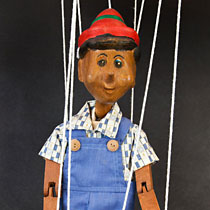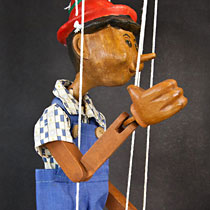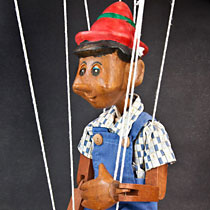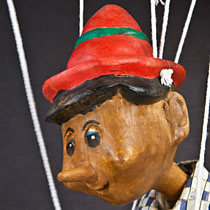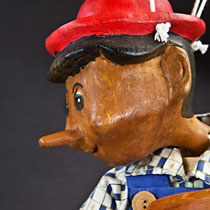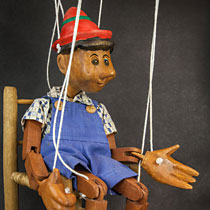Description of Figure/Doll
Pinocchio is made entirely from molded wood, and has joints at his shoulders, neck, elbows, wrist, hips, ankles, and knees. His nose is long, and he has a painted red hat on his head. He can be manipulated by eight strings. The markets in the Italian city of Florence are full of Pinocchio puppets and marionettes because the author of the Pinocchio story lived in Florence. To learn more about the culture in Italy, read the story.
Link to higher resolution images at ClipPix
Italy
Location: Europe
Capital: Rome
Main language: Italian, German, French
Currency: Euro
Figure/Doll
Construction: wood, string
Height in Centimeters: 46
Height in Inches: 18

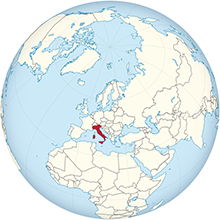
The Man Who Wrote Pinocchio: Carving a Boy from Wood
Reading Level: 6.30
Sally was on vacation in Florence, Italy, with her parents. They visited the famous sculpture of David by Michelangelo. Art and music have always been important to the culture of people living in Florence. Sally liked walking around the old city and seeing the beautiful buildings. She was puzzled, though, about why all the street vendors and shops had Pinocchio puppets for sale.
Sally loved the movie about Pinocchio and had wallpaper in her room with Jiminy Cricket, Figaro, Cleo, and the Blue Fairy. Finally, she asked a shopkeeper why Pinocchio was so popular in Florence. Proudly, the Italian lady answered, “The man who wrote Pinocchio was named Carlo and he was born in Florence almost two hundred years ago! One day Carlo saw a small boy in the plaza. The boy was having fun, but was causing a lot of trouble for his parents. Carlo decided to write a story about a “real” boy who was naughty. The story is called Pinocchio, and it begins with an old carpenter and a piece of wood. This is how the story begins:
Once upon a time there was a piece of wood. It was not an expensive piece of wood. Far from it. Just a common block of firewood, one of those thick, solid logs that are put on the fire in winter to make cold rooms cozy and warm.
I do not know how this really happened, yet the fact remains that one fine day this piece of wood found itself in the shop of an old carpenter. His real name was Mastro Antonio, but everyone called him Mastro Cherry, for the tip of his nose was so round and red and shiny that it looked like a ripe cherry.
As soon as he saw that piece of wood, Mastro Cherry was filled with joy. Rubbing his hands together happily, he mumbled half to himself:
“This has come in the nick of time. I shall use it to make the leg of a table.”
He grasped the hatchet quickly to peel off the bark and shape the wood. But as he was about to give it the first blow, he stood still with arm uplifted, for he had heard a wee, little voice say in a beseeching tone: “Please be careful! Do not hit me so hard!”
What a look of surprise shone on Mastro Cherry’s face! His funny face became still funnier.
After Mastro Cherry carved the wood, Pinocchio came to life. But Pinocchio was a naughty boy and had to learn many lessons. He and his friends (Jiminy Cricket, Cleo, and Figaro) had many adventures. When Pinocchio told a lie, his nose grew. Although Pinocchio gets into a lot of trouble, he finally learns to be generous and honest. Then the Blue Fairy kept her promise and Pinocchio became a “real” boy. The story has a happy ending: “How ridiculous I was as a Marionette! And how happy I am, now that I have become a real boy!”
The shopkeeper told Sally that Pinocchio has been translated into 260 languages and read to millions of children. “Wow!” thought Sally “No wonder Florence, Italy, is so proud of Pinocchio!

